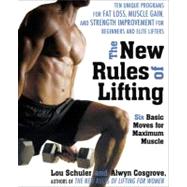
The New copy of this book will include any supplemental materials advertised. Please check the title of the book to determine if it should include any access cards, study guides, lab manuals, CDs, etc.
The Used, Rental and eBook copies of this book are not guaranteed to include any supplemental materials. Typically, only the book itself is included. This is true even if the title states it includes any access cards, study guides, lab manuals, CDs, etc.
Squat:
USED IN: Break-In; Fat-Loss I and III; Hypertrophy I; Strength I, II and III
SETUP: Place a barbell on the supports of the squat rack so that it's at upper-chest level. If the rack has safety rails on the sides, set them just below crotch level. (You want to be able to execute a deep squat without hitting those rails; they shouldn't come into play unless you get stuck on a maximum-effort squat, in which case you can simply slide the bar off your shoulders so it lands on the rails.) Duck under the bar and rest it across your upper traps, with your knees slightly bent. Grab the bar with a wide, overhand grip. Now lift it off the supports and step back so you can safely raise and lower the weights without hitting anything. (We didn't use a squat rack in these photos so we could give you a clearer view of the exercise form. You'll note that we use that strategy in several places in New Rules of Lifting. In Chapter 11, for example, we show barbell bench presses performed on a bench without uprights. IN all these cases, we thought it would be more helpful for you to see the model perform the exercise without the equipment blocking his arms or legs.)
LOWERING: Stand with your feet shoulder-width apart, or just a bit wider, your toes pointed straight ahead or angled out slightly, your shoulders tight and eyes focused straight ahead. Push your hips back, as if sitting in a chair, and lower yourself until your upper thighs are parallel to the floor, or your back starts to lose its natural arch, whichever comes first.
LIFTING: Push down through the middles of your feet—never the toes—and stand straight up. You want your torso going up and straightening, not leaning farther forward.
FOR HYPERTROPHY AND FAT-LOSS PROGRAMS: When Alwyn trains clients for these goals, he doesn't allow them to straighten their knees fully at the top of the movement. When you get almost to the top of the movement, immediately reverse directions and lower yourself for the next rep. In Strength programs, however, you'll need to stop at the top and take a deep breath (if not two) before the next rep.
Variations
Heels-raised back squat, one-and-a-quarter style
USED IN: Hypertrophy III
SAME AS ABOVE, EXCEPT...Set a pair of weight plates (5- or 10-pounders) on the floor behind you, and place your heels on the plates. Then lower yourself as described, but rise up just a quarter of the way. Lower yourself back down, then rise to the standing position. That's one repetition.
Front squat
USED IN: Fat-Loss II and III
SAME AS ABOVE, EXCEPT...Instead of ducking under the bar, you're going to rest it on your front shoulders. Grab it with an overhand, shoulder-width grip, and rotate your arms upward until your upper arms are nearly parallel to the floor. This turns your front deltoids into a pair of hooks to hold the bar in place. You won't be able to grasp the bar with your hands in this position; instead, let it roll to the ends of your fingertips. As long as you keep your arms up, it'll stay in place.